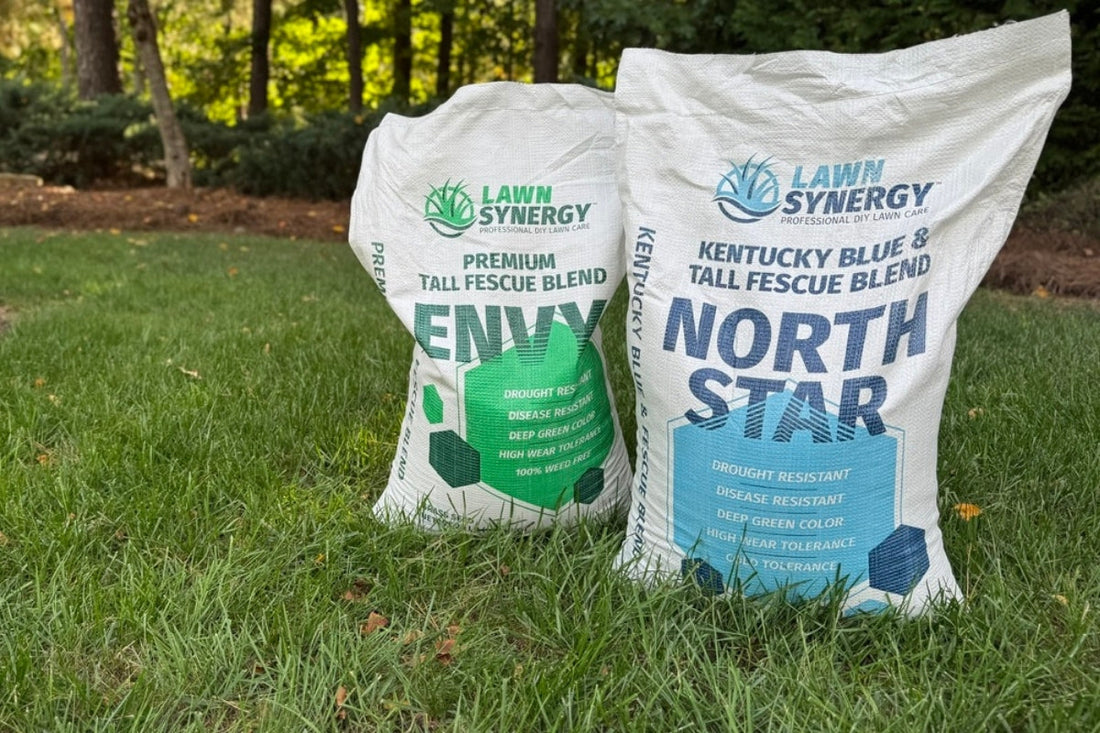Knowing when to seed lawn can be the difference between a lush, green yard and weeks of wasted effort. Timing shapes everything – how quickly a seed germinates, whether weeds take over, and how well grass establishes before weather extremes arrive.
Seeding is more than picking a bag of seed and spreading it. The right season, soil conditions, and preparation determine whether your efforts succeed or fall short.
By looking at how grass types respond to temperature, climate, and local conditions, you can align your seeding schedule with what your lawn actually needs.
What this article covers:
- Why Timing Matters for Lawn Seeding
- Best Time to Seed Cool-Season Grasses
- Best Time to Seed Warm-Season Grasses
- Regional Considerations for Lawn Seeding
- Preparing Your Lawn Before Seeding
- How to Care for a Newly Seeded Lawn
Why Timing Matters for Lawn Seeding
Seeding your lawn isn't just about tossing seed on the ground. Grass seed requires specific conditions (temperature, soil contact, and moisture) to sprout properly. Planting too early or too late can weaken seedlings, leaving bare patches where weeds thrive.
Soil temperature drives germination. Most cool-season grasses need soil around 50 to 65 degrees Fahrenheit, while warm-season varieties require 65 to 70 degrees or higher.
If temperatures swing outside these ranges, the seed either fails to germinate or sprouts unevenly. Sunlight, water, and soil health also determine whether seedlings grow thick and resilient.
Seeding at the wrong time wastes both money and effort. Poor germination can leave your lawn thin, allowing crabgrass or broadleaf weeds to establish. Overcrowding from poorly timed overseeding can also stress existing grass.
That's why preparation matters: a soil test kit, aeration, and a clean seedbed set the stage for professional-grade results.

Best Time to Seed Cool-Season Grasses
Cool-season lawns thrive in specific windows where soil and air temperatures align to promote germination without stress. Knowing these periods allows you to seed with confidence and set your lawn up for long-term resilience.
Fall Offers the Prime Window
For cool-season species such as Kentucky Bluegrass, perennial ryegrass, and tall fescue, fall is the most reliable time for seeding.
Soil retains summer warmth, encouraging fast germination, while cooler air prevents heat stress. Fall rains also support steady moisture without flooding seedlings.
Weeds grow more slowly in the fall, giving new grass less competition. By spring, seedlings have established roots and can handle foot traffic, mowing, and fertilizer more effectively.
Spring Seeding: Pros and Cons
Spring seeding is possible, but results vary. While soil warms quickly, weeds also surge, competing with young grass for space and nutrients.
If you seed in spring, be ready for consistent watering and a weed-control plan. Avoid seeding within eight weeks of applying pre-emergent herbicides, as these chemicals also block grass seed germination.
Overseeding vs. New Seeding
If your lawn is thin but not bare, overseeding in the fall works best. For a new lawn or major renovation, fall still outperforms spring, but spring can be used as a secondary option.
Many DIY homeowners choose professional-grade seed like'Envy Premium Tall Fescue for its disease resistance and adaptability in cool-season zones.
“It germinated and came in thick and lush in six days. Yard was ravaged by one of the hottest summers we've ever had … can't wait to see how it matures into the fall season.”
— Customer review of Envy Premium Tall Fescue Grass Seed

Best Time to Seed Warm-Season Grasses
Warm-season grasses respond to heat and sunlight differently from cool-season varieties, which changes the ideal seeding calendar. Pinpointing this window helps you avoid weak, drought-prone seedlings.
Late Spring Through Early Summer
Warm-season grasses such as Bermuda, Zoysia, and St. Augustine thrive in heat, but they need soil temperatures of at least 65 to 70 degrees Fahrenheit to germinate.
The ideal time is late spring into early summer, once frost risks are gone. Seeding too early in cool soil delays sprouting, while seeding too late in midsummer exposes tender seedlings to drought stress.
Proper irrigation during this window ensures rapid growth and deep root establishment.
St. Augustine Grass Considerations
St. Augustine grass is typically planted by sod or plugs, but timing still matters. Plant once nighttime lows are consistently above 60 degrees. This prevents cold shock and supports strong stolon growth. Understanding the types of St. Augustine grass available for your region helps ensure success.
Regional Considerations for Lawn Seeding
Not every lawn follows the same schedule – regional climates and even microclimates shift the timing. Factoring in your location ensures that you're not simply following generic advice but tailoring your plan to your yard's conditions.
Northern U.S.
In northern states, fall is the gold standard for cool-season seeding.
The sweet spot usually falls between late August and mid-October, when soil temperatures remain in the 50–65°F range but air temperatures cool enough to reduce stress. This window allows seedlings to establish roots before winter sets in.
Spring can be used as a secondary option, typically from April through early May, but it comes with challenges. Spring seeding demands consistent irrigation to offset unpredictable rain patterns and proactive weed control, since annual weeds germinate aggressively at the same time.

Southern U.S.
For southern homeowners, warm-season grasses dominate, including Bermuda, Bahia, and Zoysia. The best seeding window runs from late April through June, when soil temperatures are consistently 65–70°F or higher.
Planting too early risks cold soil and poor germination, while seeding too late in midsummer exposes seedlings to drought stress.
Fall seeding in the South rarely succeeds because immature grass cannot establish strong roots before the first frost. Instead, focus on warm-season establishment in spring and early summer, then shift attention to fertilizer and weed prevention in fall.
Transition Zones
The central United States, stretching through states like Kentucky, Missouri, and parts of North Carolina, presents unique challenges.
These “transition zones” are home to both warm- and cool-season grasses, but neither performs perfectly year-round. Homeowners often hedge against extreme summers and winters by blending seed varieties.
For example, tall fescue provides durability in cooler months while Bermuda holds color and density in hot summers.
Estate-level seed blends, such as Envy Premium Tall Fescue, help balance performance across variable climates.
Microclimates Matter
Even within a single property, microclimates can change seeding success. Shaded areas under trees may warm more slowly in spring, while low-lying spots may hold water and risk seed rot.
Clay soils hold heat differently than sandy soils, influencing germination rates. That's why many homeowners rely on soil tests and a simple soil thermometer to confirm readiness before planting.
Adjusting timing by just a week or two in response to these factors can make the difference between patchy results and a lush, uniform lawn.

Preparing Your Lawn Before Seeding
No matter when you seed, preparation determines whether the seed germinates or struggles. Investing time in soil health, weed removal, and aeration sets the foundation for professional-level results.
Healthy seed-to-soil contact is the foundation of strong germination. Start with a soil test to understand nutrient needs and pH.
Amend with lime, gypsum, or organic matter as needed. Lawn Synergy's Gypsum Soil Conditioner improves heavy soils, making them more receptive to seed.
Clear weeds, sticks, and debris. For existing lawns, dethatch and aerate to improve seed contact and oxygen flow.
For bare ground, lightly till and level the soil. Using a product like Seed Aide Cover Grow Mulch helps retain moisture and protect the seed from birds.
“I had previously used another brand's shade seed, and it didn't do too well. This grass seed takes some time to come in, but it fills beautifully and looks great.” – Customer review on North Star Grass Seed.
How to Care for a Newly Seeded Lawn
The first few weeks after seeding decide whether your investment pays off. Proper watering, mowing, and nutrition give seedlings the support they need to establish into a dense, healthy turf.
Watering is the most critical step. Keep the top half-inch of soil consistently moist until seedlings emerge. This often requires light, frequent watering two to three times per day.
Once grass reaches two inches, reduce to deeper, less frequent watering to encourage root growth.
Wait until seedlings reach three inches before mowing. Use sharp blades and cut no more than one-third of the height. Fertilizer should not be applied at seeding unless using a starter formula designed for young grass. Products such as Starter Fertilizer 15-20-10 provide balanced nutrients without overwhelming fragile roots.
Avoid common mistakes: overwatering, mowing too soon, or applying herbicides too early. Patience during establishment pays dividends in lawn density and durability.
“Had germination in about 7 days, 2 weeks in now and looks great!”
— Customer review of Envy Premium Tall Fescue Grass Seed
Conclusion
Seeding success always comes back to timing. Knowing when to seed the lawn ensures your grass gets the conditions it needs to thrive – warm soil, stable moisture, and less weed competition.
At Lawn Synergy, we've taken the same practices that keep estate lawns flawless and made them accessible to DIY homeowners.
Whether you're in Florida, North Carolina, or anywhere in between, our expert-backed products and step-by-step support ensure that your timing, grass seed choice, and care plan are always on point.
Ready to learn more about lawn care? Check out these articles:

